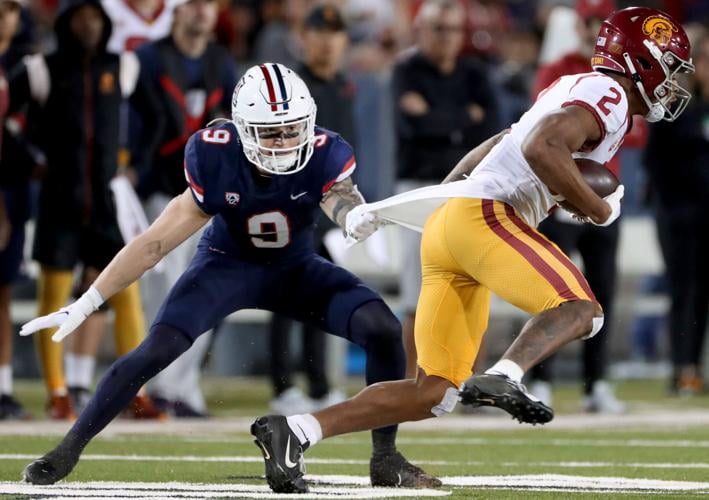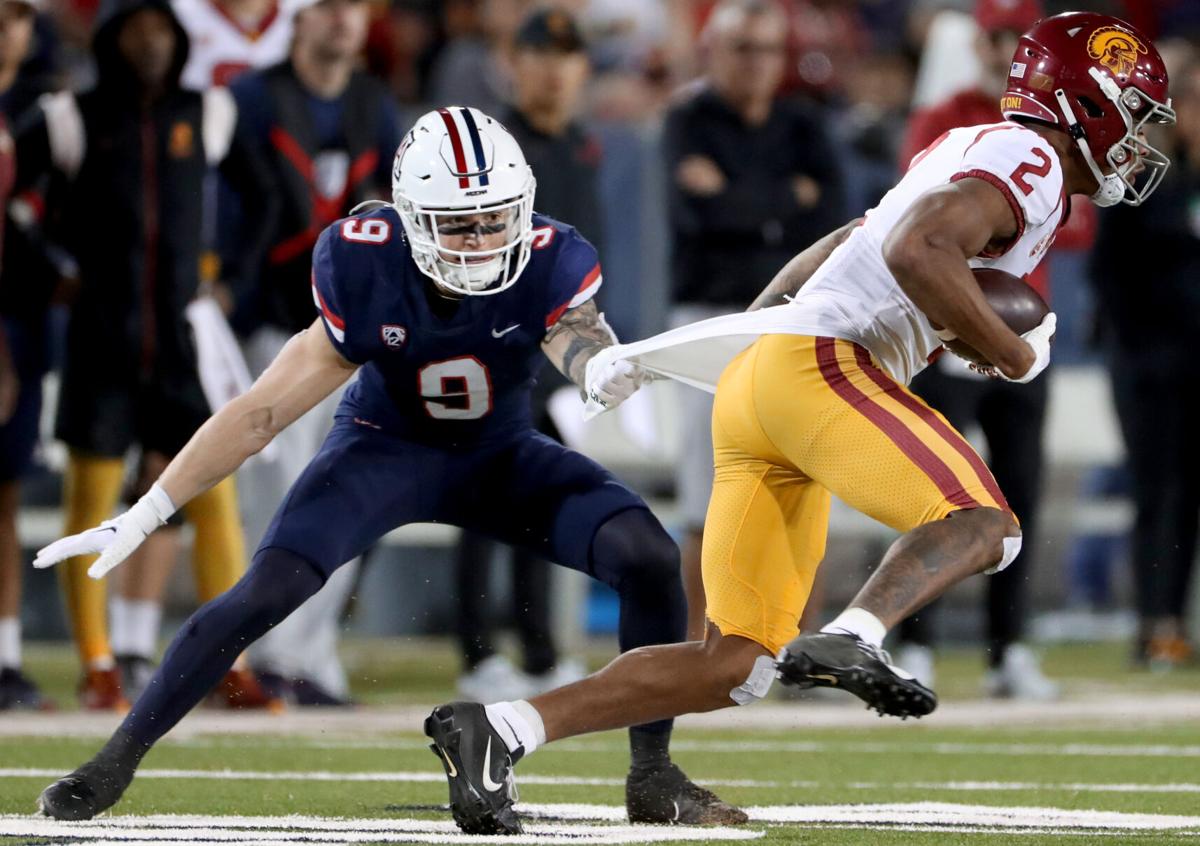On the surface, Arizona’s defense didn’t play much better against USC than it had against Washington, Oregon or Cal.
In all four games, the Wildcats allowed 45 or more points. In all four, they failed to register a sack or takeaway.
But if you look deeper — and it might require a microscope to see it — you can find subtle signs of progress.
“I thought we actually did some good things on defense,” UA coach Jedd Fisch said Monday, two days after Arizona’s 45-37 loss to then-No. 10 USC.
The first thing he pointed to was the number of third-down attempts the Trojans had. USC faced 17 third-down conversions, easily the most for a UA opponent this season. Mississippi State and Colorado each had 12. Arizona’s first seven foes averaged just under 10.
The bad news: The Trojans converted 11 of them for a 64.7% success rate. USC’s average distance to go was just 4.6 yards. (Arizona’s was 8.9.) Nearly half (eight) of the Trojans’ third downs required 4 or fewer yards. Only one was 9-plus yards.
One third-down failure came on the final possession of the game, a sequence Fisch also found praiseworthy. Needing a stop to get the ball back, Arizona limited Travis Dye to 9 yards on three carries — including a tackle for no gain by freshman linebacker Jacob Manu on third-and-1.
QB Caleb Williams kept the ball on fourth-and-1 and gained the decisive first down. Manu got a piece of him behind the line of scrimmage but not enough to complete the tackle.
“Jacob Manu was a shoestring away from getting that stop on fourth down,” Fisch said. “(It) would have been fun to see what would have happened then in that case.”
Had they gotten the stop, the Wildcats would have gotten the ball back with about a minute to play at their 37-yard line needing a touchdown and two-point conversion to tie the score.
“They had to go for it on fourth down to win that game, in my opinion,” Fisch said. “I think they thought we’d go down and score and tie the game up. That would be the only reason you would ever go for it on fourth down in that situation instead of kicking us deep and making us go 90 yards with no timeouts.”
Although they failed to sack Williams, the Wildcats did pressure him 14 times, per Pro Football Focus. That was double Arizona’s output against Washington’s Michael Penix Jr.
Williams has excelled at avoiding sacks (and turnovers) all season, and that was the case against the Wildcats as well.
“The quarterback’s a really good player,” Fisch said. “There were some times that against other players there would have been a much better chance to get him down. One of the most impressive ones was the end of the game.”
Manu was one of three true freshmen who started on defense and one of six who played on that side of the ball. That’s another cause for optimism.
All six played at least 12 snaps, per PFF, with Manu leading the way at 80. He tied for third on the team with seven tackles.
Cornerback Ephesians Prysock made his first career start and had a team-best 57.1% completion rate against, per PFF (minimum two targets).
No one was able to take the ball away, though, and that remains a major problem. Arizona forced six turnovers in its first three games. It has just one in its past five.
“If we could just take the ball away a few times,” Fisch said, “that would make a huge difference.”
‘There was no foul’
Fisch also said this about Arizona’s defensive performance vs. USC:
“I think there were some unfortunate plays that were called that didn’t allow us to show some of the times that we get off the field.”

Arizona linebacker Jerry Roberts, left, arrives a second too late as USC running back Travis Dye manages to pitch the ball on a reverse in the third quarter.
He was referring to the personal foul called against linebacker Jerry Roberts for bumping into Williams along the UA sideline early in the fourth quarter. Williams had thrown the ball away on third-and-8 from the Arizona 22. The Trojans likely would have attempted a 39-yard field goal. They ended up scoring a touchdown.
“It should not have been a foul,” Fisch said Monday. “It is what it is. There was no foul there.”
The questionable call cost Arizona four points. At the end of the first half, an officiating error prevented USC from kicking a field goal. If both situations had been handled correctly — and both field-goal attempts were successful — the Trojans would have had one fewer point. Their lead would have been 37-29 (one possession) with 13:38 to play instead of 38-29 (two possessions).
Utah injury update
As they prepare for this week’s game at No. 12 Utah, the Wildcats can’t be certain which version of the Utes they’ll face.
Utah played without quarterback Cameron Rising and running back Tavion Thomas against Washington State last week. Running back Micah Bernard was limited to eight snaps, and star tight end Dalton Kincaid got hurt during the game.
Utah coach Kyle Whittingham indicated Monday that none of the injuries was season-ending. Asked whether Rising — a last-minute scratch — would be back this week, Whittingham said: “We hope so.”
Fisch said the primary focus within the Lowell-Stevens Football Facility is on self-improvement, regardless of the opposition.
“We gotta worry about us,” Fisch said. “We gotta figure out how we’re going to play better fundamentally. I don’t think it’ll really matter whether their tight end plays or doesn’t play, running back plays, doesn’t play, see what happens with Cam.
“For us, it’s going to be: Can we be more gap-sound? Can we beat their tackles in pass rush? Can we improve on our line games? Can we find a better way or more consistent way to cover their guys down the field?
“And then whoever they play will determine what we need to do — if we need to change a coverage or adjust something. But for the most part right now, it’s all about us. It’s all about: Can we get better at all of our fundamentals and techniques? So whoever lines up, we line up and play better.”
Extra points
Arizona ended up with only nine players on the field when USC missed a 56-yard field goal in the second quarter. “I’m glad we weren’t at eight,” Fisch quipped. He and his staff assumed the Trojans were going to punt, and the Wildcats were left shorthanded in the ensuing shuffling of players. They also were out of timeouts, having lost their last one on an unsuccessful replay challenge.
Utah (6-2, 4-1 Pac-12) is favored by 17.5 points over Arizona (3-5, 1-4). The line opened at 16.5. The Utes have won the past five meetings.
The start time for Arizona’s road finale against UCLA on Nov. 12 won’t be announced until Saturday night or Sunday morning. The possibilities include 5 p.m. on Fox or FS1, 5:30 or 7 p.m. on Pac-12 Networks, 8 or 8:30 on ESPN or 8 or 8:30 on Fox.






